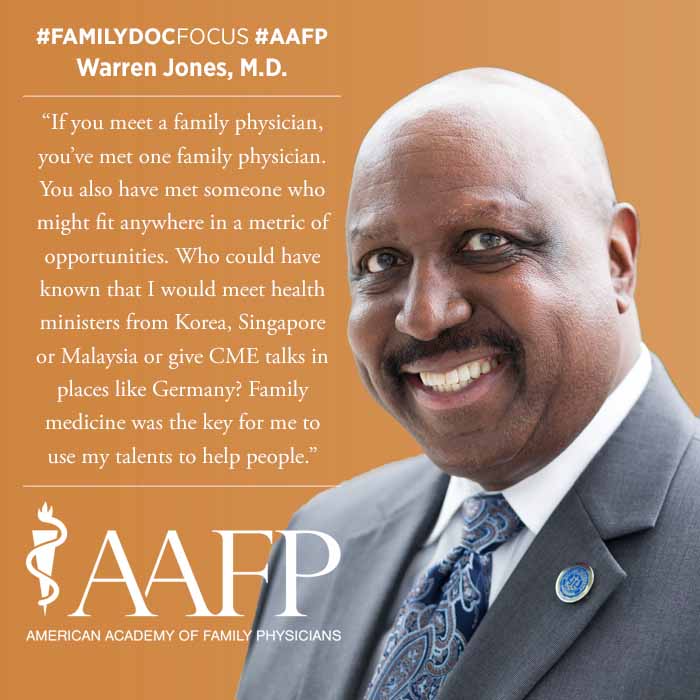Family Medicine Is Key to Abundant Opportunities
October 14, 2019 10:05 am David Mitchell – Two retirements haven't slowed down former AAFP President Warren Jones, M.D.
Jones had served 28 years when he retired from the Navy as a captain in 2001. Eleven years after that, he retired from the University of Mississippi in Oxford. Seven years later, Jones is still working -- at age 71 -- as the chief health officer for Hampton University in Hampton, Va.
"If you meet a family physician, you've met one family physician," Jones said of the diverse career paths available in the specialty. "You also have met someone who might fit anywhere in a metric of opportunities. Who could have known that I would meet health ministers from Korea, Singapore or Malaysia or give CME talks in places like Germany? Family medicine was the key for me to use my talents to help people."
Jones grew up in a New Orleans housing project as one of 12 children to a mother who was a domestic worker and a father who was a cab driver. Jones and his siblings were taught to give back to their community and told that education was the best way to position themselves to do that.
Jones completed his residency training in family medicine at the naval hospital in Pensacola, Fla., where his experience included work in the ER, ICU, labor and delivery unit and neonatal ICU.

"I was able to do full-spectrum family medicine because I was trained in a military family medicine facility," he said. "I was able to become a residency director the day after I graduated and trained my colleagues. I have been able to do a myriad of roles."
In addition to 20 years of direct patient care, Jones' roles in the Navy included serving as chair of the family medicine department at the naval hospital in Charleston, S.C., and as special assistant to the Navy surgeon general. He spent two years in Honolulu as TRICARE medical director for Alaska, Hawaii and Southeast Asia. By the time he retired, he was senior medical director for the entire TRICARE program.
Jones retired from the Navy when his term as AAFP president began in 2001, and he started the first of two stints at the University of Mississippi. First, he served as associate vice chancellor for multicultural affairs at the University of Mississippi Medical Center. He also served as deputy director, and later director, of the Mississippi Area Health Education Centers.
During his time there, the school started a program that provided scholarships in return for a pledge that graduates would later practice in rural areas for four years. The program addressed rural health access and increased minority enrollment. The average number of minority students in Mississippi's medical school classes eventually increased from five per class to 20 per class.
Jones left the University of Mississippi Medical Center in 2004 to become executive director of the state's Medicaid program. There, he directed implementation of the Medicaid medical home model, including quality programs and policies that are still in place. After a year and a half in that role, he returned to the University of Mississippi as a distinguished professor of health policy and senior health policy adviser. A year later, he added the role of first executive director of the Mississippi Institute on Geographic Minority Health. Jones and his staff secured more than $35 million in funding for health disparities research and programs.
From 2014 to 2017, Jones oversaw the implementation of a $25 million NIH grant for health disparities research at his alma mater, Dillard University in New Orleans, before taking on his current role at Hampton, which also is related to health disparities research.
And for the first time in more than a decade, Jones has taken on a leadership role with the Academy, serving on the AAFP Foundation's Board of Trustees.
"When you've had the opportunity to go through the Academy's leadership roles, it's time to give other people a chance at their dreams," he said. "It's not about what I do, so I got out of the way."
He was drawn back, in part, by the Foundation's work with students and residents.
"I love what they do, identifying young people with capabilities and skills and helping them find out who they are," he said.
Jones got his own start in national leadership at what was then a new AAFP event: the National Conference of Women, Minorities and New Physicians. The since renamed National Conference of Constituency Leaders serves as a leadership and policy development event for women; minorities; new physicians; international medical graduates; and lesbian, gay, bisexual, and transgender physicians or physician allies.
"I wasn't looking to be a leader, but my chapter asked me to go that first year," Jones said of the inaugural conference in 1990.
In the ensuing years, NCCL participants have served on AAFP commissions, represented their state chapters in the Congress of Delegates and been elected to the Board of Directors.
Jones, the AAFP's first black president, was at the COD Sept. 25 in Philadelphia when Gary LeRoy, M.D., of Dayton, Ohio, was installed as the second black Academy president, and Ada Stewart, M.D., of Columbia, S.C., became the first black woman named president-elect.
"Our Academy has opened its eyes," Jones said of the Board's heightened diversity. "When you look at our membership, one of the strengths of the Academy is our diversity of experience and thought.
"Jimmy Carter once said our country wasn't a melting pot but a tapestry of cultures and ethnicities. That's what the Academy is. It's a beautiful tapestry."